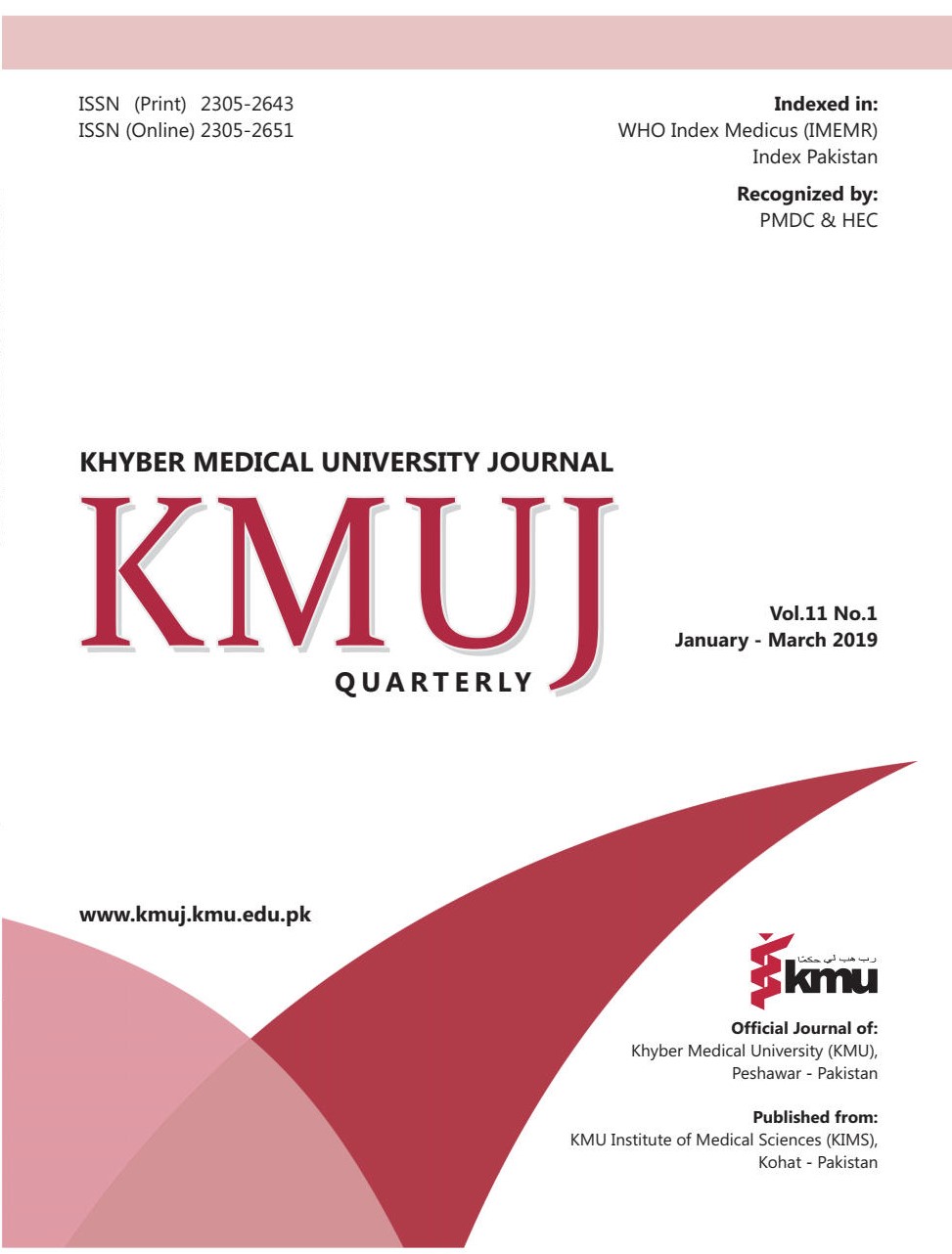ULTRASOUND GUIDED HYDROSTATIC REDUCTION OF INTUSSUSCEPTIONS IN CHILDREN WITH LATE PRESENTATION
Main Article Content
Abstract
METHODS: Retrospective analysis was done for 68 paediatric patients in the age range from 2.5 months to 6 years at Radiology & Paediatrics departments, Medical Teaching Institution Lady Reading Hospital, Peshawar. Children primarily diagnosed as intussusception, based on ultrasound findings & managed conservatively with ultrasound guided hydrostatic reduction from January 2014 to December 2017 were included in the study. Their management was analyzed with respect to duration of symptoms. Children who were primarily managed surgically were excluded from study.
RESULTS: A total of 68 patients in the age range from 2.5 months to 6 years were included in the study. Male to female ratio was 3.25/1 with 52 males (≤1 year=45 & ˃1year=7) and 16 females (≤1 year=11 & ˃1 year=5). Abdominal pain was reported in all (100%) cases, followed by bleeding per rectum in 35.2% and abdominal mass in 13.2% cases. Classic triad of abdominal pain, abdominal mass and bleeding per rectum was reported only in 8.8% of cases. Overall rate of success of hydrostatic reduction was 89.70% (n=61/68). Success rate in cases presented ≤48 hours was 97.56% and in cases presented >48 hours was 77.77% (p<0.05).
CONCLUSION: Hydrostatic reduction for intussusception in paediatric patients under ultrasound guidance has a good outcome. Success rate for patients presenting presented ≤48 hours was better than patients presenting presented ≥48 hours.
Article Details
Work published in KMUJ is licensed under a
Creative Commons Attribution 4.0 License
Authors are permitted and encouraged to post their work online (e.g., in institutional repositories or on their website) prior to and during the submission process, as it can lead to productive exchanges, as well as earlier and greater citation of published work.
(e.g., in institutional repositories or on their website) prior to and during the submission process, as it can lead to productive exchanges, as well as earlier and greater citation of published work.
References
REFERENCES
Caruso AM, Pane A, Scanu A, Muscas A, Garau R, Caddeo F, et al. Intussusception in children: not only surgical treatment. J Pediatr Neonat Individual Med 2017;6(1):e060135. DOI: 10.7363/060135.
Gluckman S, Karpelowsky J, Webster AC, McGee RG. Management for intussusception in children. Cochrane Database of Systematic Reviews 2017;6:CD006476. DOI: 10.1002/14651858.CD006476.pub3.
Ogundoyin OO, Olulana DI, Lawal TA. Childhood intussusception: A prospective study of management trend in a developing country. Afr J Paediatr Surg 2015;12(4):217-20. DOI: 10.4103/0189-6725.172541.
Blanch AJ, Perel SB, Acworth JP. Paediatric intussusception: Epidemiology and outcome. Emerg Med Australas 2007;19(1):45-50. DOI: 10.1111/j.1742-6723.2007.00923.x.
Chen SCC, Wang JD, Hsu HY, Leong MM, Tok TS, Chin YY. Epidemiology of Childhood Intussusception and Determinants of Recurrence and Operation: Analysis of National Health Insurance Data Between 1998 and 2007 in Taiwan. Pediatr Neonatol 2010;51(5):285-91. DOI: 10.1016/S1875-9572(10)60055-1.
Jiang J, Jiang B, Parashar U, Nguyen T, Bines J, Patel MM. Childhood Intussusception: A Literature Review. PLoS ONE 2013;8(7):e68482. DOI: 10.1371/journal.pone.0068482.
Ekenze S, Mgbor S. Childhood intussusception: The implications of delayed presentation. Afr J Paediatr Surg 2011;8(1):15-8. DOI: 10.4103/0189-6725.78662.
Marsicovetere P, Ivatury SJ, White B, Holubar SD. Intestinal Intussusception: Etiology, Diagnosis, and Treatment. Clin Colon Rectal Surg 2017;30(1):30-9. DOI: 10.1055/s-0036-1593429.
Usang U, Inah G, Inyang A, Ekabua A. Intussusception in children: Comparison between ultrasound diagnosis and operation findings in a tropical developing country. Afr J Paediatr Surg 2013;10(2):87-90. DOI: 10.4103/0189-6725.115029.
Bartocci M, Fabrizi G, Valente I, Manzoni C, Speca S, Bonomo L. Intussusception in childhood: role of sonography on diagnosis and treatment. J Ultrasound 2015;18(3):205-11. DOI: 10.1007/s40477-014-0110-9.
Carroll AG, Kavanagh RG, Ni Leidhin C, Cullinan NM, Lavelle LP, Malone DE. Comparative Effectiveness of Imaging Modalities for the Diagnosis and Treatment of Intussusception. Acad Radiol 2017;24(5):521-9. DOI: 10.1016/j.acra.2017.01.002.
Annigeri VM DS, Gadgade B, Halgeri AB, Bagalkot PS. Childhood intussusception: A 7 years prospective analysis of data in a single center. Int J Health Sci Res 2017;7(1):34-8.
Imran M, Ayub M, Yunas M, Aslam V, Rehman IU, Manan A. Non-operative reduction of Intussusception in infants. J Postgrad Med Inst 2009;23(1):81-5.
Hasnain Z, Ali M, Khalid MM, Irfan-Ul-Haq. Ileo-colic intussusception; is hydrostatic reduction worth considering till late? Professional Med J 2014;21(5):864-8.
Lehnert T, Sorge I, Till H, Rolle U. Intussusception in children--clinical presentation, diagnosis and management. Int J Colorectal Dis 2009;24(10):1187-92. DOI: 10.1007/s00384-009-0730-2.
Jehangir S, John J, Rajkumar S, Mani B, Srinivasan R, Kang G. Intussusception in southern India: Comparison of retrospective analysis and active surveillance. Vaccine 2014;32:99-103. DOI: 10.1016/j.vaccine.2014.03.028.
Nasir AA, Nwosu D, Bamigbola KT, Abdur-Rahman LO, Obiora MA, Gobir AA, et al. Economics and clinical implications of delayed presentation of children with intussusceptions: minimizing healthcare cost in the context of limited resources. Egypt J Surg 2018;37(4):600-05. DOI: 10.4103/ejs.ejs_113_18.
